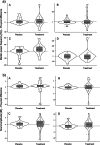Acute effects of a single bout of exercise therapy on knee acoustic emissions in patients with osteoarthritis: a double-blinded, randomized controlled crossover trial
- PMID: 35820904
- PMCID: PMC9277782
- DOI: 10.1186/s12891-022-05616-y
Acute effects of a single bout of exercise therapy on knee acoustic emissions in patients with osteoarthritis: a double-blinded, randomized controlled crossover trial
Abstract
Background: Knee osteoarthritis is associated with higher kinetic friction in the knee joint, hence increased acoustic emissions during motion. Decreases in compressive load and improvements in movement quality might reduce this friction and, thus, sound amplitude. We investigated if an exercise treatment acutely affects knee joint sounds during different activities of daily life.
Methods: Eighteen participants with knee osteoarthritis (aged 51.8 ± 7.3 years; 14 females) were included in this randomized crossover trial. A neuromuscular exercise intervention and a placebo laser needle acupuncture treatment were performed. Before and after both interventions, knee joint sounds were measured during three different activities of daily living (standing up/sitting down, walking, descending stairs) by means of vibroarthrography. The mean amplitude (dB) and the median power frequency (MPF, Hz) were assessed at the medial tibial plateau and the patella. Differences in knee acoustic emissions between placebo and exercise interventions were calculated by analyses of covariance.
Results: Controlled for participant's age, knee demanding activity level and osteoarthritis stage, the conditions significantly differed in their impact on the MPF (mean(± SD) pre-post-differences standing up: placebo: 9.55(± 29.15) Hz/ exercise: 13.01(± 56.06) Hz, F = 4.9, p < 0.05) and the amplitude (standing up: placebo:0.75(± 1.43) dB/ exercise: 0.51(± 4.68) dB, F = 5.0, p < 0.05; sitting down: placebo: 0.07(± 1.21) dB/ exercise: -0.16(± .36) dB, F = 4.7, p < 0.05) at the tibia. There were no differences in the MPF and amplitude during walking and descending stairs (p > 0.05). At the patella, we found significant differences in the MPF during walking (placebo 0.08(± 1.42) Hz/ exercise: 15.76(± 64.25) Hz, F = 4.8, p < .05) and in the amplitude during descending stairs (placebo: 0.02 (± 2.72) dB/ exercise: -0.73(± 2.84) dB, F = 4.9, p < 0.05). There were no differences in standing up/ sitting down for both parameters, nor in descending stairs for the MPF and walking for the amplitude (p > 0.05).
Conclusion: The MPF pre-post differences of the exercise intervention were higher compared to the MPF pre-post differences of the placebo treatment. The amplitude pre-post differences were lower in the exercise intervention. In particular, the sound amplitude might be an indicator for therapy effects in persons with knee osteoarthritis.
Trial registration: The study was retrospectively registered in the German Clinical Trials Register ( DRKS00022936 , date of registry: 26/08/2020).
Keywords: Activities of daily living; Knee joint sound; Knee osteoarthritis; Neuromuscular exercise; Vibroarthrography.
© 2022. The Author(s).
Conflict of interest statement
The authors declare that the research was conducted in the absence of any commercial or financial relationships that could be construed as a potential conflict of interest.
Figures




References
-
- Souza Moreira ACS de, Luiz Cardoso F, ZarpellonMazo G, Santos GM. Influence of the clinical in postural balance in woman with knee osteoarthritis. IPMRJ. 2019. 10.15406/ipmrj.2019.04.00188.
-
- Bennell KL, Egerton T, Wrigley TV, Hodges PW, Hunt M, Roos EM, et al. Comparison of neuromuscular and quadriceps strengthening exercise in the treatment of varus malaligned knees with medial knee osteoarthritis: a randomised controlled trial protocol. BMC Musculoskelet Disord. 2011;12:255. doi: 10.1186/1471-2474-12-276. - DOI - PMC - PubMed
Publication types
MeSH terms
LinkOut - more resources
Full Text Sources
Miscellaneous

